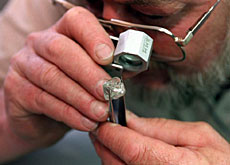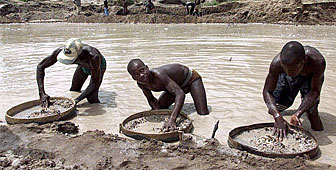Governments target illicit diamond trade

Government ministers are meeting on Tuesday in the Swiss town of Interlaken in an attempt to end the trade in so-called "conflict" diamonds.
They are expected to agree new international rules stipulating that uncut diamonds must be accompanied by detailed records of provenance.
Diamond producing, trading and marketing countries, working with the diamond industry, have been developing the regulations to track the origin of diamonds and stamp out illicit trading.
The ministerial meeting on Tuesday is aimed at wrapping up the Kimberley Process – negotiations that began more than two years ago.
The United Nations revealed at the time that diamond production was financing deadly conflicts in diamond producing nations such as Angola, Sierra Leone, Congo and Liberia.
Stung by the criticism, governments, non-governmental organisations and diamond traders were then forced to take a closer look at how business was being conducted.
Key player
Switzerland was seen as key player in the process because it was the world’s third biggest diamond trading centre, after London and Antwerp.
However, the diamond trade in Switzerland collapsed this year, following the decision by De Beers – the world’s largest producer – to relocate its headquarters from Lucerne to London.
Last year, SFr2 billion worth of diamonds was traded in Switzerland; in the first seven months of this year that figure had fallen to SFr7 million(see related story “Switzerland loses sparkle as diamond trading centre”).
The worldwide production of rough diamonds was worth $7.8 billion (SFr11.4 billion) in 2001. Most of the gems came from Botswana, South Africa, Canada and Russia.
Conflict, or “blood” diamonds as they are sometimes referred to, are believed to make up between two and four per cent of the annual global diamond trade.
Policing system
The Interlaken meeting should finalise an international policing system agreed to by more than 30 governments over the past year. The agreement is supposed to be implemented on January 1 2003.
All diamond shipments would have to carry a certificate citing their origin, their weight and their value in dollars, the identities of the importer and the exporter, the date the gems were shipped and carry an official stamp.
“The Process is open to every country that is prepared to follow these rules,” said Roland Vock of Switzerland’s State Secretariat for Economic Affairs (Seco).
“All the important actors of the diamond trade have signed up already.”
Vock believes the Kimberly Process should also ensure that the diamond trade is not thrown into unwanted turmoil.
“Some countries’ development depends on the diamond trade,” he said. “Their growth would have suffered if Anglo-Saxon NGOs had carried out their boycott threats.”
Self-regulation
Revelations by the UN that the diamond trade was being used to fund bloody conflicts dealt a heavy blow to the industry.
Sales were threatened, forcing traders to introduce their own regulations.
To counter the bad publicity, major trading centres have now set up rules to track the origin of diamonds.
Diamond sales must now be accompanied by a “chain of warranties”, invoices stating that the gems don’t come from an area where rebel forces are using them to finance a military campaign against a legitimate government.
Non-governmental organisations say, however, that industry self-regulation is an inadequate solution, arguing that there is a lack of detailed monitoring procedures.
“This is not the auditable chain of warranties that the Kimberley Process has been discussing for more than a year,” said Ian Smillie, research coordinator for the non-governmental organisation, Partnership Africa Canada.
However, campaigners admit that the Kimberley Process is not flawless either. It was meant to include the publication of detailed statistics on diamond production and export, but no agreement has been reached on who will coordinate, analyse or make public those statistics.
Flawed process
“There is no independent control mechanism,” said Anna Feric, of Amnesty International’s Swiss section. “The Process is also implemented on a voluntary basis by states.”
Another weakness in the Process is the fact that it only refers to uncut diamonds. The gems would only have to be partially polished to escape regulation.
“Some producing countries may be tempted to set up their own polishing industry,” said Seco’s Vock. “But it may not be as easy as they think it might be.”
Vock says the Kimberley Process is still in its infancy and admits that much remains to be done.
“After it is launched, it will probably have to be adapted. But it does fill a hole in the legislation and is satisfactory as far as traders are concerned.”
swissinfo with agencies
Worldwide production of rough diamonds was worth SFr11.4 billion in 2001.
Most gems come from Botswana, South Africa, Canada and Russia.
Conflict diamonds are believed to make up between two and four per cent of the annual global diamond trade.
Major producers of conflict diamonds are Angola, Sierra Leone, Congo and Liberia.
The Interlaken meeting is to finalise a global policing system to curb the trade in such stones.
The system would give every uncut diamond a certificate of origin.
Critics say its effectiveness would be limited because gems would only have to be partially polished to escape regulation.

In compliance with the JTI standards
More: SWI swissinfo.ch certified by the Journalism Trust Initiative




You can find an overview of ongoing debates with our journalists here . Please join us!
If you want to start a conversation about a topic raised in this article or want to report factual errors, email us at english@swissinfo.ch.